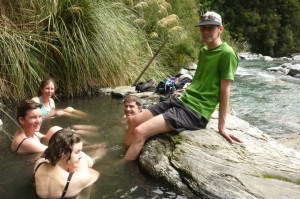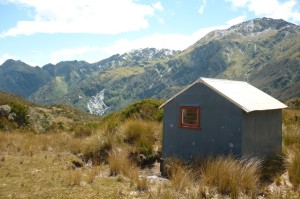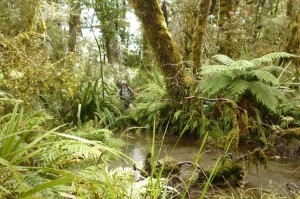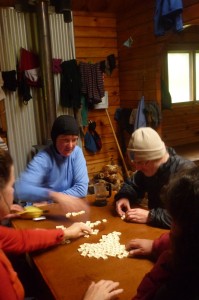If they served tramping trips in restaurants, then this trip might have been called the Westland tasting menu. The group convened in Hokitika on boxing day. Some had had an entrée in the Arthur’s Pass area, others dived straight into the main course. After more than a little debate about the best location for weather and optimal routes, we decided to divide our original planned week-long tramp into two parts. This decision was based on the fact that the forecast indicated three days of fair weather followed by approximately a week of rain. Our first preference route would have been risky with this forecast as all exit routes involved river crossings that could become impossible with heavy rain. Instead we decided to do a three day mini-tramp along the Toaroha River and onto the Toaroha Range, followed by a separate wet-weather tramp in the rainforest around the Moeraki River and the Haast-Paringa Cattle track.
Tramp 1: Mini-tramp of Toaroha River and Range

Our walk in from the Lake Kaniere road-end was along the beautiful Toaroha River. After an unremarkable (baby weka excluded) but pleasant few hours we arrived at Cedar Flats which was to be our first hut for the trip. The main attraction here was the nearby hot pools. Given that it was a wonderfully hot and sunny day, and given the abundance of sand-flies at the hut, we were quick to proceed to the pools. As hot pools go, these were top-notch. There was just enough space to fit all five of us comfortably, and the proximity of the river allowed for multiple rounds of hot-pool-to-cold-river plunging. Only an accompanying bottle of bubbly could have improved the experience, but fresh mountain river water sufficed.
The next day we set off up Yeats Ridge with the aim of getting above the bush-line and perhaps to the tops of the Toaroha range. A brutal ascent ensued, but with the aid of the permolat markers and some very handy roots for hauling ourselves up on, we finally emerged at some scenic tarns with wonderful views across to Zit Saddle, Adventure Ridge and Genoa Peak. It wasn’t far from there to Yeats Ridge Hut. Yeats Ridge Hut is an absolute cracker of a hut – painted blue with a red door, its stunning location more than makes up for the lack of toilet and nearby water supply. Thank you Permolat for maintaining this little gem of a hut! The hut book stretched back to 1982, and as far as we could see we were the first WTMC visitors. From Yeats Ridge Hut a group of us carried on up the ridge to a sub-top at 1300m. In the blistering heat, this was all we had energy for, but the views across the Southern Alps were well worth the effort.

After a restful night in Yeats’ company, our final day of tramp 1 involved back-tracking down Yeats Ridge and out to the bus at the road end. The descent down the ridge was almost as gruelling as the ascent had been, but we managed it without too many bruises and proceeded easily back out along the river. Debbie campaigned for a stop at the hot pools en-route, but the rest of the group felt keen to move on to the next dish on the menu: Rainforest served with a side order of rain.
Tramp 2: Moeraki River and the Haast-Paringa Cattle Track
The group felt the need to cleanse the palette in-between tramp 1 and tramp 2, and, Debbie (who is a connoisseur of bathing) established that this could be done at Hokitika public pool for the princely sum of $3. Refreshed and ready for the next course, we hopped into the van and zipped down to Franz for a quick overnight camp by the road. This re-emergence into civilisation reminded us exactly what we go tramping to get away from, so we packed up camp sharp in the morning, had a quick huddle in the Franz DOC office, acquired the appropriate maps and set off to the end of the Haast-Paringa Cattle track.
From the car park, the track proceeded to get wetter and wetter. A signal of things to come was given when Beccy saw a fish swimming along the track. However, as the going underfoot got damper and damper, and the sections of swamp wider, the rainforest only got more and more varied and spectacular. After a spot of lunch at Blowfly hut we continued on up the Moeraki River to Horseshoe Flat hut. This is a great little hut set in verdant surrounds, and with the added bonus of a family of blue duck including 6 ducklings on the adjoining river. The photographers in the group (Spencer and Ian) were really in their element here capturing close ups of the rainforest mosses and soft focus scenes of a rushing Moeraki waters. Mother Nature even laid on a double rainbow above the hut for added effect.

Overnight the rain got increasingly persistent and heavy, so some took the opportunity for a little lie-in in the morning, whilst others used the time for photography, and Debbie and Beccy ventured further up the valley for a couple of kilometers to get the views into the hills. We all re-convened later and walked back out to Blowfly hut which was to be our final hut of 2013. Beccy, being the youngster of the group, was a little dismayed to discover that no-one else intended to stay up to see in 2014, so she resigned herself to seeing in the new year in the post-box like bunks of Blowfly hut. Blowfly hut is a cute little hut in a lovely little spot, but the top bunks are far too close to the ceiling which caused much hilarity as some very weary trampers tried to contort themselves into bed.
2014 arrived and brought rain, the proper West Coast no-messing-about sort of rain, so the group donned their waterproofs and wet boots and headed on along the Cattle track to Maori Saddle hut. The Haast-Paringa Cattle track is one of those magical old routes. Created in 1875, it was used by farmers from the Landsborough and Cascade valleys to drive their cattle to the sale yards at Whataroa. As we walked along it you could almost hear the cattle still mooing and the shouts of the herders still echoing across the creeks – but it turned out it was just Spencer who does surprisingly good cattle noises. The route is mostly very easy with only a few areas of windfall and a handful of thundering creeks to cross. As Ian said, the creeks were ‘all bark and no bite’, sounding ominous on the approach, but in reality being small and steep sided, and fairly easy to get across. We negotiated the stretch of track to Maori saddle hut in an unexpectedly quick 6 hours (the signs indicted 9hours) and were very happy to get the fire on to dry out our kit a bit in the relatively spacious Lockwood construction hut.

From Maori Saddle hut we had the option of continuing the next day along the cattle track and exiting via Coppermine Creek Hut, or returning the way we came to the Northern Car Park. The forecast wasn’t getting any drier and there were a number more creeks and rivers the Coppermine’s way. Whilst we mainly felt we had had our fill of this wet West Coast Rainforest, there was still the nagging urge to complete the route. Throughout the trip we had been communicating with our sister group (call sign JG42) via the mountain radio, and in the end the decision about our route out was clear when we heard they were due out the next day. We didn’t think it fair on the good folk of Hokitika that we inflict the stench of JG42 on them for an extra 24hrs before we brought them the van with their clean clothes. The majority felt this was good decision anyway, as we had been pretty wet for a few days by the time we got to Maori Saddle Hut and the prospect of crossing the potentially flooded Coppermine Creek was not a universally popular one. So, on our final day, the JG49 cattle herd made quick work of the Cattle track back to the Northern Car Park and civilisation.
